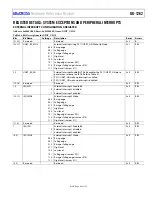
UG-1262
Rev. B | Page 35 of 312
ARM CORTEX-M3 PROCESSOR
The
contains an embedded Arm Cortex-M3 processor. The Arm Cortex-M3 processor provides a high performance, low
cost platform that meets the system requirements of minimal memory implementation, reduced pin count, and low power consumption,
and delivers computational performance and system response to interrupts.
ARM CORTEX-M3 PROCESSOR FEATURES
The high performance features of the Arm Cortex-M3 processor are as follows:
A 26 MHz maximum clock speed.
128 kB of embedded flash memory with error correction code (ECC).
32 kB system SRAM with parity.
32 kB user configurable instruction or data SRAM with parity. 4 kB of SRAM can be used as cache memory to reduce active power
consumption by reducing access to flash memory.
1.25 Dhrystone million instructions per second (DMIPS)/MHz.
Many instructions are single cycle, including multiply.
Separate data and instruction buses allow simultaneous data and instruction accesses to be performed.
Optimized for single cycle flash usage.
A flexible RTC that supports a wide range of wake-up times.
Three general-purpose timers and one watchdog timer.
Programmable GPIOs, each with optional input interrupt capability.
The low power features are as follows:
PMU.
POR and PSM.
Buck converter for improved efficiency during active state.
The core is implemented using advanced clock gating so that only the actively used logic consumes dynamic power.
Power saving mode support (hibernate mode). The design has separate clocks to allow unused parts of the processor to be stopped.
The advanced interrupt handling features are as follows:
The NVIC supports up to 240 interrupts. The
supports 64 of these interrupts. The vectored interrupt feature greatly
reduces interrupt latency because there is no need for software to determine which interrupt handler to serve. Additionally, there is
no need to have software to set up nested interrupt support.
The Arm Cortex-M3 processor automatically pushes registers onto the stack at the entry interrupt and retrieves them at the exit interrupt.
Pushing and retrieving reduces interrupt handling latency and allows interrupt handlers to be normal C functions.
Dynamic priority control for each interrupt.
Latency reduction using late arrival interrupt acceptance and tail chain interrupt entry.
Immediate execution of an NMI request for safety critical applications.
The system features are as follows:
Support for bit band operation and unaligned data access.
Advanced fault handling features include various exception types and fault status registers.
The debug support features are as follows:
Serial wire debug (SWD) port.
Flash patch and breakpoint (FPB) unit for implementing breakpoints. Limited to two hardware breakpoints.
Data watchpoint and trigger (DWT) unit for implementing watchpoint trigger resources and system profiling. Limited to one
hardware watchpoint. The DWT does not support data matching for watchpoint generation because it has only one comparator.















































